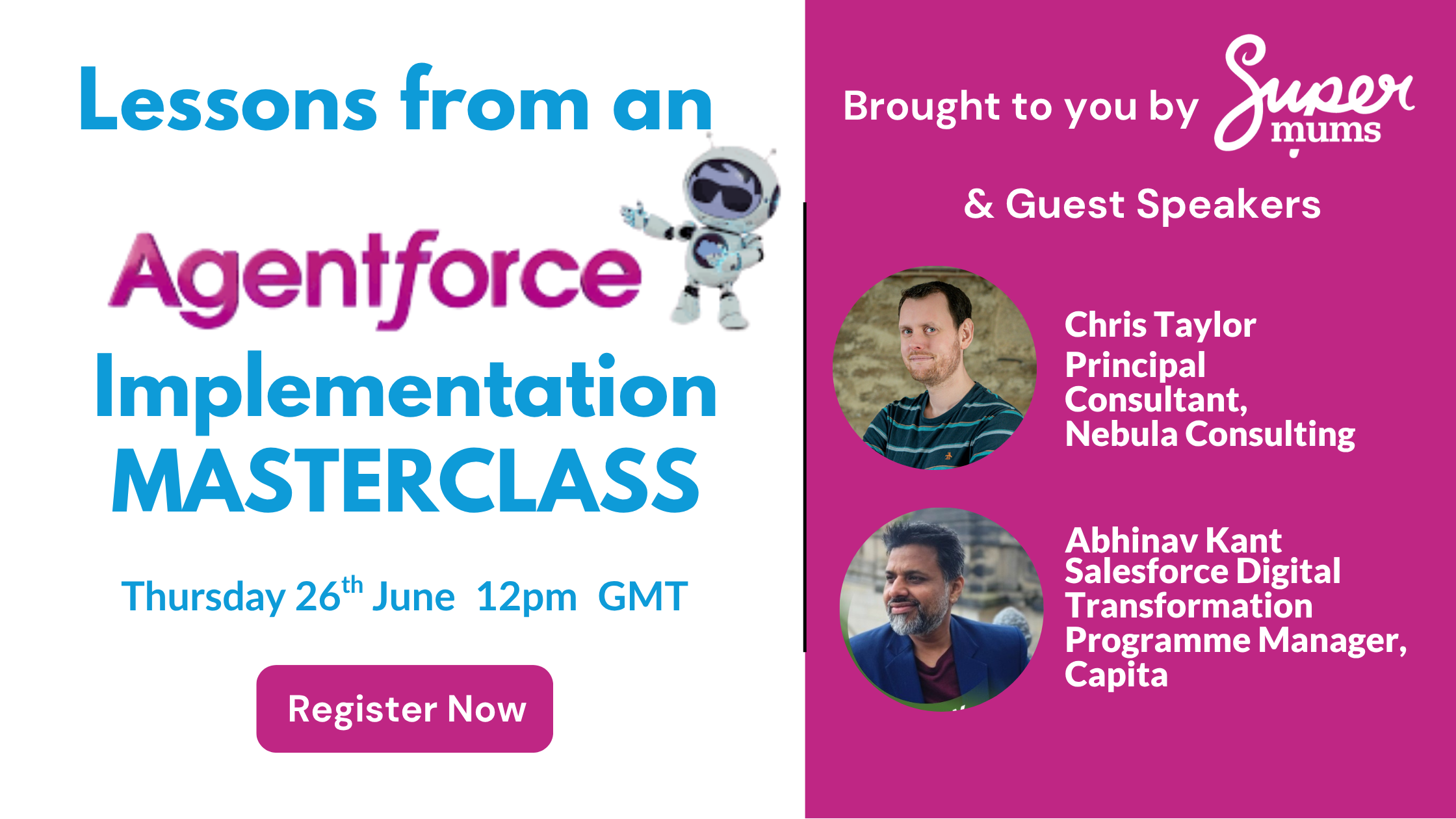How to Build a Successful Digital Transformation Road Map
By Heather Black

This month’s CPD session is focussed on how to build a successful transformation road map, from Vonage, as they share steps an organization can follow to achieve short-term and long-term business goals with the use of digital technology. Don’t forget to join us for demo’s and live Q&A’s with them during our CPD Office Hours on 20th & 27th July.

The Supermums CPD Programme focusses on equipping Salesforce talent with essential skills to enhance their CV and salary.
Sign up to our CPD programme to benefit from our weekly top tip bulletin, monthly office hours events with free Demo’s and Q&As, exclusive discounts, events and training.
During this month’s Supermums CPD Office Hours we’re focusing on how to build a successful transformation road map including steps an organization can follow to achieve short-term and long-term business goals with the use of digital technology, including a live demo from Vonage.
- EMEA Office Hours – 20th July at 9.30am BST – Register Here
- USA CPD Office Hours – 27th July at 11am PT / 2pm ET – Register Here
What is a Digital Transformation Road Map and How Do You Build one?
A digital transformation plan is a set of steps organizations can follow to achieve short-term and long-term business goals with the use of digital technology. It begins by understanding business needs and finding gaps in the existing system — and then building a strategy that fills these gaps.
To build your digital transformation road map, you should try to answer the following questions:
- What resources are required?
- What inputs and deliverables do we need and from which teams?
- What is the timeline?
Digital transformation is an ongoing process with many possible paths to success. Businesses that get it right can decrease operating costs by up to 70%, cut inventory costs in half, and increase revenue by 20%, according to IBM.
Why is it Important for Your Department?
Although most executives agree that digital transformation is a must, they don’t always agree on how to do it. Without a road map, new investments can be a hard sell to senior management — and for good reason. McKinsey & Company research shows that 70% of large-scale digital transformation initiatives fail due to “a lack of employee engagement, inadequate management support, poor or nonexistent cross-functional collaboration, and a lack of accountability.”
Meaningful organizational change takes more than planning; it takes a change in mindset. A successful digital transformation road map doesn’t just explain what needs to be done and how to do it. It also illustrates why change is necessary and why it will be worth the investment, which makes innovation a no-brainer for everyone involved — from decision-makers to end-users across the organization.
What Does a Digital Transformation Road Map Look Like?
No two organizations are the same, and neither are their digital transformation journeys. But successful road maps typically include plans for addressing similar challenges and opportunities, such as:
Digital Transformation Goal Setting
A successful road map outlines not just how a business will approach digital transformation, but also why. What widespread problems will it solve for your specific business, and will it provide a competitive advantage? Unprecedented talent shortages and ever-changing regulations for healthcare providers might put “boosting staff efficiency” or “improving compliance” at the top of their lists, while manufacturers might be more focused on optimizing processes and improving supply chain visibility. Retailers, meanwhile, might prioritize customer service improvements and personalizing communications.
Getting Executive Buy-In and Budget
Digital transformation requires time, talent, and money, which means it needs C-suite support. Along with identifying companywide digital transformation goals, the road map should account for the goals and vision that individual executives have for their own departments or business functions and communicate how digital transformation will help them achieve it. The chief financial officer, for example, will want to know how digital transformation can cut costs or create new revenue streams, while the chief customer experience officer might be more interested in engaging new customers or delighting existing customers with better service or new communication channels.
Assembling the Right Team
Creating a successful digital transformation road map isn’t something IT leaders can do alone. It requires a deep understanding of how each team works and how they could work better. It also requires insight into how customers want to engage with the business and how their experience could be improved. That means it requires a team of multidisciplinary leaders across the organization — including digital strategists, sales and marketing directors, and other business unit leaders, among others. These people can help identify problems, choose solutions, and get everyone on the same digital page, where solutions are not redundant, technology is integrated, and important data never gets siloed. They can also help implement new solutions in their departments and get their teams on board.
Employee Engagement
Even the best-laid digital transformation plans will go awry without employee engagement. While some departments are likely begging for new technology, others might see it as a hassle if they’re not prepared for the change. The road map should include plans to engage employees in advance, solicit their input and feedback, and ensure they understand how digital transformation will improve their work lives. Businesses can choose the perfect customer relationship management (CRM) process to sync customer data and streamline sales, but it won’t improve customer engagement if the sales and customer service reps never update it. And even if new clinical communications solutions would vastly improve productivity for overburdened employees, they might not make time to learn how to use it unless they’re convinced it’s worth the effort.
Flexible Development
Digital transformation is a complicated process. Deploying it in one go is usually impossible. Focus on executing the transformation efforts in phases and testing the project in a focus group before scaling it up. It’s a good idea to start with projects that are less complex, easy to deploy, valuable, and financially viable. The idea is to get a return on your investments early on. You should prepare to be flexible in terms of what aspects of your plan actually are implemented. Sometimes technology changes; sometimes priorities change. A flexible road map has a greater chance of success.
How to Ensure Your Road Map’s Success
Digital transformation is not one and done. It’s a series of mini-projects, with new implementations and integrations and ongoing adjustments and iterations. Sometimes those iterations are because the team’s needs have evolved; other times, it’s because the technology has evolved. Leading cloud software providers are continually updating their solutions and rolling out new features, from artificial intelligence (AI) and internet of things (IoT) capabilities to new integration opportunities. By regularly evaluating existing solutions, IT can find new ways to add value via digital transformation.
With each new implementation, it’s also important to set and track key performance indicators (KPIs) and gather stakeholder feedback. This makes it clear what’s working, what’s not, and when the road map needs to be edited. It also provides opportunities to celebrate success and validate that the company is on the right path to digitization.
Cloud communications are critical for digital transformation. Find out why — and how to make the migration — in our whitepaper, How to Move Communications to the Cloud.
In this whitepaper, you’ll learn:
- Why communications are a key part of digital transformation, and what comprises “communications” for the modern enterprise
- Why the timing is ripe for cloud migration, as legacy on-premises tools were designed for a world that no longer exists
- The key criteria and best practices for choosing the right cloud communications provider for your company
- Whether your business would benefit most from a single cloud provider vs. a multiple cloud model


Join us for our June CPD Office Hours
Join our CPD Office Hours this month as we focus on how to build a successful transformation road map including steps an organization can follow to achieve short-term and long-term business goals with the use of digital technology, including a live demo from Vonage.
- EMEA Office Hours – 20th July at 9.30am BST – Register Here
- USA CPD Office Hours – 27th July at 11am PT / 2pm ET – Register Here

Written By:
Subscribe To Our Weekly Top Tip Bulletin
Get Updates And Learn From The Best











